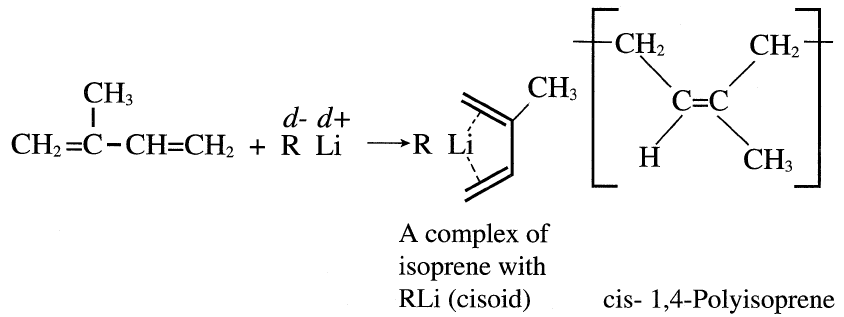
Anionic Polymerization
 المؤلف:
sami matar & Lewis. F. Hatch
المؤلف:
sami matar & Lewis. F. Hatch
 المصدر:
Chemistry of PETROCHEMICAL PROCESSES
المصدر:
Chemistry of PETROCHEMICAL PROCESSES
 الجزء والصفحة:
p 308
الجزء والصفحة:
p 308
 18-9-2017
18-9-2017
 1761
1761
Anionic Polymerization
Anionic polymerization is better for vinyl monomers with electron withdrawing groups that stabilize the intermediates. Typical monomers best polymerized by anionic initiators include acrylonitrile, styrene, and butadiene. As with cationic polymerization, a counter ion is present with the propagating chain. The propagation and the termination steps are similar to cationic polymerization.
Many initiators, such as alkyl and aryllithium and sodium and lithium suspensions in liquid ammonia, effect the polymerization. For example, acrylonitrile combined with n-butyllithium forms a carbanion intermediate:

Chain growth occurs through a nucleophilic attack of the carbanion on the monomer. As in cationic polymerizations, lower temperatures favor anionic polymerizations by minimizing branching due to chain transfer reactions.
Solvent polarity is also important in directing the reaction bath and the composition and orientation of the products. For example, the polymerization of butadiene with lithium in tetrahydrofuran (a polar solvent) gives a high 1,2 addition polymer. Polymerization of either butadiene or isoprene using lithium compounds in nonpolar solvent such as n-pentane produces a high cis-1,4 addition product. However, a higher cis-1,4-polyisoprene isomer was obtained than when butadiene was used. This occurs because butadiene exists mainly in a transoid conformation at room temperature (a higher cisoid conformation is anticipated for isoprene):

 الاكثر قراءة في البترو كيمياويات
الاكثر قراءة في البترو كيمياويات
 اخر الاخبار
اخر الاخبار
اخبار العتبة العباسية المقدسة


